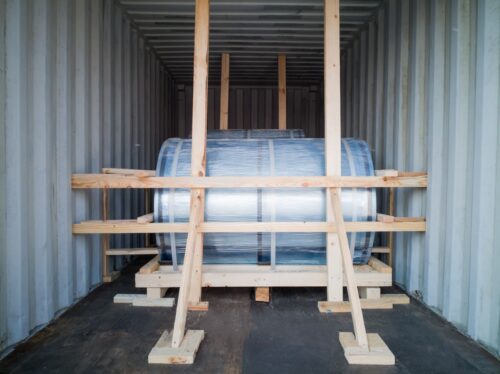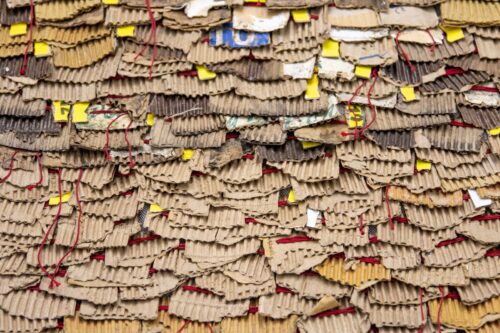What Is Dunnage? Definition, Uses, and Types

Dunnage is a type of material used to fill empty spaces on ships, trucks, and other vehicles. Dunnage trucking helps to prevent shifting and damage during transport. Common materials used for dunnage include wood, metal, and plastic.
This article will look at the definition of dunnage, its uses, and the available types. It will also provide tips on choosing the right type of dunnage or packing materials for your needs.
Whether loading a container for shipment or preparing a vehicle for off-road travel, damage protection dunnage can help keep your cargo safe and secure.
What Is Dunnage?
To define dunnage, it is any material used to support or elevate cargo to protect it from damage during transport. This can include everything from wood blocks and styrofoam peanuts to air bags and bubble wrap.
Dunnage comes in many different forms, but its primary purpose is always to keep cargo safe and secure during transit. There are many benefits to using dunnage, but the most important is that it helps prevent damage.
By cushioning and stabilizing cargo, proper dunnage can help to protect against shifting, vibration, and impact. This can save businesses a significant amount of money in repairs and replacements. In addition, dunnage can also help to improve safety by reducing the risk of injury from falling or shifting cargo.
Types of Dunnage Materials
Here are the materials commonly used for dunnage, the use for each material, and examples of when to use it or which industries use it.
Solid Plastics
Plastic dunnage is one material that is used to protect shipments from damage. It is often made from high-density polyethylene, a solid and resilient type of plastic.
This material is ideal for safeguarding shipments from abrasions, as it will not scratch or damage the items it comes into contact with.
Additionally, plastic dunnage is often used to stack pallets and shield heavy or sharp objects. This type of dunnage is commonly used in the shipping industry, as it can prevent damage to high-value or delicate shipments.
Additionally, many industries utilize plastic dunnage to protect their products during transport. Plastic dunnage is an essential part of the shipping and logistics industry thanks to its durability and versatility.
Bubble Wrap
A vast amount of bubble wrap is used yearly to protect fragile transit items. Its popularity is due to its low cost and the fact that it is reusable. If the bubbles are not popped, bubble wrap can be used again. There are different types of bubble wraps with varying sizes of bubbles.
It is used to fill gaps in packaging and stop contents from moving. Bubble wrap is commonly used in the electronics, ceramics, and glass industries.
Wood

Wood is a sturdy material that can support and stabilize heavy loads. This makes it ideal for use in dunnage. By filling spaces with wood, the overall weight of the shipment is balanced out, making it easier and safer to move with a forklift or other machinery.
Additionally, the wood helps to protect the goods from shifting and banging into each other, which could potentially damage them.
You can use this dunnage in industries such as transportation and logistics, where there is a need to load and unload heavy shipments frequently. By using wood dunnage, businesses can safeguard their products and ensure they are handled safely and efficiently.
Air Pillows
Shippers often use air pillows as dunnage in packaging and shipping. They are used to fill empty spaces in boxes and to prevent items from sliding and colliding with the sides of the box. In addition, air pillows serve to protect objects and keep them safe during transit.
They are commonly used in packaging electronics, glassware, and other fragile items. Air pillows are also used in some industries to protect delicate equipment during shipping and handling.
Kraft Paper
Kraft paper is a type of paper frequently used in building and packaging. It is created from wood pulp that has undergone chemical treatment to make it strong and resilient. Kraft paper is often used to make bags, envelopes, and boxes.
It can also be a wrapping material or a container liner. In many cases, kraft paper is recycled and repurposed. For example, it can be used as animal bedding or mulch for gardens. Kraft paper is also often used in the construction industry. For instance, it can be used for insulation, vapor barriers, or flooring underlayment.
Kraft paper can also be used as dunnage. Dunnage helps to prevent damage to the goods during transport. Kraft paper is an essential material for many industries, and its uses are constantly expanding.
Foam
Foam is a versatile material used for various purposes. In the shipping industry, it is often used as dunnage, or packing material, to protect delicate items from damage during transit. Foam can be cut into any shape and size, making it ideal for custom packaging.
It is also lightweight and holds its shape well, so it won’t shift and damage the items inside. Foam is often used to ship medical equipment, as it helps to ensure that delicate instruments arrive intact.
It can also be used for furniture cushioning or as construction insulation. Foam is a versatile material with many uses, making it an essential part of many industries.
Steel Dunnage Meaning
Steel is a popular choice for dunnage, particularly for high-value items. Steel is strong and durable, making it ideal for heavy products or requiring extra protection. It is also a good choice for products that might be damaged by other materials, like wood or plastic.
In addition, steel is easy to clean and can be reused multiple times. However, steel is also one of the most expensive options for dunnage. As a result, it is essential to weigh the benefits and drawbacks of using steel before making a decision.
Generally, steel is a good choice for valuable products that need extra protection during shipping.
Corrugated Paper

Corrugated Paper is composed of two liner boards with fluting in between. It is among the most economical and versatile packaging materials used today. The material can support a variety of weights, making it ideal for dunnage.
Corrugated paper is also moisture resistant, which helps protect items during transit. In addition, corrugated paper is recyclable and biodegradable, making it a more eco-friendly option than other packaging materials.
Due to its many benefits, corrugated paper is widely used in various industries, including shipping, automotive, and food and beverage.
Packing Peanuts
Packing peanuts, also known as foam peanuts, foam popcorn, or packing noodles, are a common loose-fill packaging and cushioning material used to prevent damage to fragile objects during shipping. They are shaped to interlock when compressed and free flow when not compressed.
Custom Dunnage
In logistics, the term “custom dunnage” describes packaging designed to specific dimensions to protect fragile items during shipment better. This type of dunnage is often used for high-value or sensitive items, providing an extra layer of protection.
Custom dunnage can be made from various materials, including foam, plastics, and even metal. The choice of material will depend on the items you’re shipping and the required level of protection. For example, items susceptible to corrosion may require metal dunnage, while delicate electronics might be best protected by foam padding.
In some cases, custom dunnage may even be required by law or regulation. For example, shippers must ship certain types of medical equipment in padded containers that meet specific standards.
Benefits and Uses Dunnage
When it comes to shipping, dunnages are often an afterthought. But many shippers need to realize that dunnage can provide several benefits for their shipments.
From damage protection to shock absorption, dunnage can help ensure that shipments arrive at their destination in the same condition they left in. Here are five ways that dunnage can benefit your shipments:
Damage Protection
While dunnage fills space, it also plays an essential role in protecting fragile items from damage. For example, corner protectors can help prevent goods from being crushed during transit, while foam padding can help absorb shock and avoid breakage.
In addition, dunnage can also keep goods from shifting around during transit, which can help to reduce the risk of damage. As a result, using dunnage is essential to ensure that goods arrive at their destination in perfect condition.
Moisture and Contamination Protection
Dunnage helps to keep cargo from shifting during transit, preventing damage to the shipment and the container itself. In addition, floor dunnage can protect from moisture and contamination. By absorbing moisture and protecting against spills, dunnage helps to keep cargo clean and dry.
As a result, it is an essential component of any safe and effective shipping operation. Dunnage is relatively inexpensive and easy to procure, making it a wise investment for any business that ships merchandise regularly.
Shock Absorption
When it comes to preventing damage during shipping, one of the most important things to consider is shock absorption. Airbags are the most effective shock-absorbing dunnage. Airbags are inflated with compressed air and then placed between the load and the walls of the container.
They act as cushions, absorbing shocks and vibrations and keeping the contents safe. In addition to protecting against physical damage, airbags help prevent moisture damage by creating a barrier between the load and the outside environment.
As a result, using dunnage can be an effective way to protect your shipment from damage.
Easy Handling of Heavy Items
One of the significant benefits of dunnage is that it makes it much easier to handle heavy items. By filling in the gaps between the items, dunnage prevents them from shifting around during transport.
This makes it much easier for workers to load and unload the items since they don’t have to worry about them moving around. Additionally, dunnage can help to protect delicate items from damage during shipping.
Cushioning the items and preventing them from moving around helps prevent scratches, dents, and other forms of damage.
Air Circulation
Another benefit of dunnage is that it helps to improve air circulation. Air circulation is crucial in the case of food storage, as poor air circulation can lead to spoilage.
By using dunnage to create gaps between containers, organizations can ensure that air can circulate freely and that food stays fresh for longer. This improved airflow also helps to prevent mold and mildew from forming, which can cause significant damage to stored goods.
Is Dunnage Reusable?
Dunnage is reusable if it can withstand being used multiple times without losing its effectiveness. There are different types of dunnage; some are more reusable than others.
Air cushions, for example, are often used as reusable dunnage because they are lightweight, have high strength, and have an unprecedented capacity to absorb vibrations.
Cardboard boxes and wood pallets are also common types of reusable dunnage. Generally, any dunnage that is durable and can be reused multiple times without losing its usefulness is considered reusable.
Alternate Types of Primary Packaging
In addition to dunnage, two other types of primary packaging options are available: component packs and unit loads. Component packs are tinier packs that protect individual components within a product.
For example, you may individually wrap electronic components in component packs to prevent them from being damaged during shipping. On the other hand, unit loads are larger packages that consolidate multiple products into a single shipment.
For example, a pallet of bricks would be considered a unit load. As a result, manufacturers can reduce the number of shipments by using unit loads, saving time and money.
Kit Packs
Kit packaging is a type of packaging where several similar items are put together into one box and delivered to recipients. This type of packaging is often used for products that need to be shipped in bulk, such as food kits or medical supplies.
Kit packaging can also be used for promotional purposes, such as when a company sends out free samples of its product. When done correctly, kit packaging can be an efficient and cost-effective way to ship products.
However, if not done carefully, kit packaging can result in damaged goods or lost items. For this reason, working with an experienced and reputable kit packer is vital when using this type of packaging.
Multi-Material Varieties
Multi-material packaging is a type of packaging constructed from a single material or a few different components, such as paper, plastic, and aluminum foil.
This type of packaging is often used for food and beverage products, as it can protect against moisture, oxygen, and other contamination. Multi-material packaging can also be more durable than single-material packaging, making it ideal for products that require extended shelf life.
In addition, multi-material packaging can create unique product designs that are visually appealing and functional. However, one drawback of multi-material packaging is that it can be more difficult to recycle than single-material packaging.
As a result, companies that use this type of packaging need to dispose of or recycle the materials properly.
